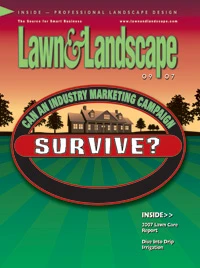Tim Thoelecke Jr. has a working list of words that should be banished from landscape designers’ vocabularies. “Decorate” is one of them. The phrase “for interest” is another – as in “We’re going to put this flowering tree here for interest.”
Maybe it’s the former English major in Thoelecke, landscape designer/project manager for Schmechtig Landscapes, Mundelein, Ill., that has him hung up on word choice. Or the fact that he comes from a family of educators and recently has become one himself. (In 2006 Thoelecke founded the American Academy of Landscape Design, which he runs in the off season.) Or maybe it’s his strong emphasis on what he calls “design thinking.”
“The design itself is about creating spaces that have a relationship to one another,” Thoelecke says. “I love a well-conceived movie or book just the same. When you see a well-designed landscape, everything is motivated – the view from the kitchen table, the relationship between the architecture and a hardscape element like a pergola, patio or swimming pool.” So-called designers who are “decorating” or adding plants “for interest” probably aren’t correctly following the design process and are doing their clients a disservice, Thoelecke says. He knows there are a lot of landscape designers committing these faux pas – “Look at all the ugly landscapes,” he says, half seriously.
There’s another word Thoelecke says designers should banish – this one’s on the business side of the profession and it’s a biggie: sales. The thought of not saying this vital term probably sounds like heresy to business owners, but, Thoelecke cautions, “People don’t like to be sold to, but people love to buy.” Using “consult” instead will do a lot to gain clients’ (not “customers”) trust. (For more words landscape designers shouldn’t use, see “Vocabulary Lesson,” on page S5.)
“The biggest challenge in our industry is getting contractors and designers out of the mind set of selling stuff,” Thoelecke says. “If we want to be perceived as someone other than ‘the landscaper,’ we need to act differently.” To do so Thoelecke says designers should position themselves as an advocate. “Clients can be intimidated,” he says. “So if we put ourselves in the position of being their advocate or adviser, we gain their trust. And the sales will take care of themselves.”
During the 17 years he ran his own company, Garden Concepts, Thoelecke learned that a slower than typical design process allowed him to exercise his philosophy of design thinking while pleasing clients. The steps he takes before getting to the drawing phase have helped him maintain the mentality of crafting well-conceived gardens – and not just selling stuff. Take a look at Thoelecke’s approach and see what tips you can take away.
1. Phone call. During the initial inquiry, Thoelecke works from a set of talking points to get a feel for whether the relationship will be a “good fit” – in terms of property, budget and designer-client rapport. Quick Tip: Always discuss design fees. To avoid pinning yourself down before understanding the scope of the project, consider quoting a range of fees for a “typical” quarter-acre subdivision lot.
2. First meeting. During this “get acquainted” meeting, Thoelecke scopes out the property, further discusses fees and assigns homework – a short questionnaire. Quick Tip: Tell couples that you expect their survey to come back with two different types of handwriting, encouraging both decision makers to express their opinions early in the process.
3. Second meeting. Upon return of the questionnaire, Thoelecke revisits the home to take measurements and share an idea book with more than 100 photos of various landscape styles and designs. Quick Tip: Number each photo and ask clients to log which photos they like and, more importantly, dislike.
4. Concept stage. After gathering information, Thoelecke presents clients with a conceptual drawing as well as a conceptual budget. This stage gives clients an overall feel for their new landscape, like the connections between the garden and the architecture of the home, and an idea of price range. “It’s not a budget or contract – it’s giving them an idea if it will be $5,000 or $500,000,” Thoelecke says. Quick Tip: Frame your pitch within terms clients care about – don’t just tell them what plant will go where. “Talk about what it’s going to feel like when they walk through.”
5. Drawings/proposal. Finally, Thoelecke presents working drawings and a proposal. “I really work hard not to sell them something they don’t need,” he says, noting phases are always an option. “I’d rather do one portion well and leave a good taste in their mouth than do all of it poorly.” Quick Tip: “Always think, ‘If it were my money, how would I spend it?’”

Explore the September 2007 Issue
Check out more from this issue and find your next story to read.
Latest from Lawn & Landscape
- ExperiGreen, Turf Masters Brands merge
- EquipmentShare cuts ribbon on new Maryland branch
- Strathmore acquires Royal Tree Service in Montreal
- In a new direction
- The December issue is now live
- Ignite Attachments debuts 80-inch, severe-duty bucket
- EquipmentShare breaks ground on Roswell branch
- NaturaLawn of America adds Schwartz, Medd to operations team





